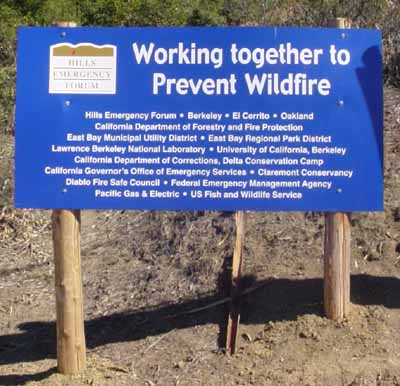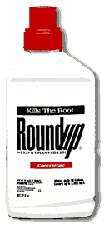
Icon from Council Member Jean Quan's website: cheery pesticide sprayer icon: Sprinkle, Sprinkle Little Star
Toxic Effects of Proposed Pesticides (Overview)
Useful One Pager to Send to Friends (Public Works Testimony)
Links to Groups Opposing Pesticide Expansion (with comments on Ordinance)
Media
Transcript of 2-8-05 KPFA newscast with notes and clarification
Council Matters
Letter to Council from Cancer Prevention Coalition
Letter to Council from NCAP staff scientist
Letter to Council from Oakland Permaculture Institute
Final Report from Quan to Public Works and Public Safety Committees
Jean Quan Supplemental IPM Report to Council
Earlier Draft of Proposed Exemptions to Oakland IPM Ordinance
Earlier News
March 4. Staff and Councilmembers who are proposing the amendment to the IPM (Integrated Pest Management) policy have accepted City Attorney John Russo's vigorous recommendation that such a policy change, introducing toxics into the environment, requires environmental review under the provisions of CEQA (California Environmental Quality Act).
Thanks everybody for showing up at the Public Works and Public Safety Hearings February 22 and March 22.
Oakland
Wants to Use Pesticides in the Hills

Intersection
at Grizzly Peak (photo: Paul Goettlich, mindfully.org)
There is No Quick Fix!
By MAXINA VENTURA
printed Berkeley Daily Planet 3-15-2005
In 1997 Oakland banned the use of pesticides on city-owned property. Since then, the city has made either two, a dozen, nine (according to an IPM document), or about half a dozen exemptions. It all depends on which day you hear Jean Quan or her policy analyst, Sue Piper, make their pesticide presentation. Bad news. Now there's a push to employ herbicides in the hills, specifically Glyphosate (Roundup) and Triclopyr (Garlon). We urge people to speak up for alternatives to renewed dependence on toxics, the same old Monsanto snake oil. After pesticides have been applied, goat-herders wait a year plus another rainy season before they'll let goats graze. Good move, as about 20 goats keeled over and died in the Spring of 1998, in the Carneros District of the Southern Sonoma Valley, immediately after drinking runoff from the neighbor wine grape grower's vineyard. He is a user of Roundup, as well as other herbicides and other pesticides. Let's not climb the toxic treadmill. Make weeding community service instead..
Recently, Oakland City Councilember Jean Quan and the Wildfire Prevention Assessment District held a meeting at City Hall to discuss this latest roll-back. Presenters included Tom Klatt (UC Berkeley Office of Emergency Preparedness); Nancy Brownfield (IPM specialist, East Bay Regional Parks), representatives from East Bay MUD, and a former president of the California Native Plant Society. No organization identifying pesticides as poisons was allowed to make a presentation.
I knew we were in for a ride when the Native Plant Society man asserted, "We need chemicals as one tool in our arsenal. ...you cannot do it without it," boasting he's been using pesticides for five decades. He doesn't know how privileged he is. At 77, heís of the last generation grown in his mother's womb, living his delicate years without toxic pesticides.
East Bay Pesticide Alert gave panelists and attendees toxicological profiles full of authoritative references, many of them government studies. Unfortunately, panelists ignored these profiles. Instead, they parroted words originating with chemical companies: small quantity; least toxic; minimal risk; reasonable; proper; limited; judicious; careful. Now imagine a child in the ER, gasping for air due to pesticide drift; hikers tracking residues home to pets; wild animals dying brutal chemical deaths; native plants dying, inviting non-natives to take over -- the bleak reality of pesticide use.
Pesticide manufacturers want to focus the publicís attention on their products' so-called "active" ingredients. But we also need to look at the so-called "inert" ingredients, and the break-down products of both, the metabolites. For instance, a surfactant added to Roundup, POEA, is routinely contaminated in manufacturing by the carcinogen dioxane. One of Roundup's metabolites is formaldehyde, another carcinogen. Triclopyr breaks down into TCP. In lab tests, TCP exposures as small as 0.2 parts per million inhibited the growth of neurons. And TCP appears to accumulate in fetal brain tissue. Tumors in rats and mice, kidney problems in dogs, the list goes on and on (see links to profiles at www.eastbaypesticidealert.org).
But you wouldn't know this from listening to Nancy Brownfield, who just goes by the labels. No wonder every ranger I talk to is agitated by her forcing pesticide use in the Regional Parks.
Proponents of herbicide use say we must poison the environment in order to save it.
But soil health is key to getting rid of fire-welcoming non-natives. Mycorrhizal fungi colonize about the roots of native plants, funneling them nutrients, while starving non-natives of nutrition, tying off the tumor, so to speak. But herbicides inhibit this crucial work. Pesticides are not the answer.
We've demanded an environmental impact report. Both the Friends of Sausal Creek and the Sierra Club had made the same request, back in November of 2003, as vegetation management had been done in such a way as to cause some problems due to lack of proper oversight by the city. Now the city is ready to unleash poisons, and still has produced no EIR. Are they trying to weasel out of a process intended to make sure damage is not done to the environment, people or animals, a process we would expect based on the California Environmental Quality Act? What about the fact that we are talking Prop 65 chemicals here? How about the endangered Pallid Manzanita and Alameda Whipsnake? How about pollinators whose work would be lost to the whole region? What about acclimated species which depend on eucalyptus, for instance?
Where is their list of alternatives tried? Oh, yeah. That's right: The Wildfire Prevention Assessment District body was just formalized in November of 2004, with monies from assessees being due in early January, 2005. The Oakland Tribuneís article of Jan. 14 was the first clue most anyone, including those who were assessed, got about the plan for pesticide use (and yes, Jean and Sue, we are glad you recently, finally, acknowledged that herbicides are a category of pesticides, as are fungicides, rodenticides, etc.). Interesting to hear from Ms. Quan that she and Friends of Sausal Creek had been working together for over half a year already on drafting the pesticides plan... the plan preceded even the formal existence of the WPAD body! They say timing is everything. So between November, 2004 and Jan. 14, 2005 were they out like busy beavers trying alternatives to toxics? One thing we do know is that we have never been told how they could have determined, before the existence of the WPAD body, that no alternatives to toxics were viable. People have been told that the city is doing this as a last resort. How, exactly, did they get from A-Z in one and one-half month's time? Why, they didn't even leave themselves a full winter, or any spring, to try out a hot foam system employing corn and coconut as its base, or a high-pressure hot water system which shows great promise? A simple flaming machine (backpack and wand system) used in many municipalities could be a great alternative for paths. What about good, old-fashioned discing, or using a weed wrench? Maybe controlled burns which native people's used successfully without burning down their much more quickly-flammable homes? Corn starch could prove a good option, as could 10 percent vinegar. Mowing is an old fave, and cherry pickers to avoid creating erosion on sensitive hillsides could work in some settings.
The $1.7 or $1.8 million available yearly (again, they've been loose with numbers... as I told them, I could put that $100,000 discrepancy to good use here) would buy over 80,000 hours labor, based on $20/ per hour, representing $15 hourly wage, plus $5 hourly to make up for lack of benefits paid independent contractors.... to do hand pulling and other non-toxic methods. With reasonable wages you could retain the knowledge base season to season. Make the job financially-worthwhile enough that people plan their years based on working certain months for the WPAD. Maybe put $30,000 into a serious volunteers coordinator, whose job and therefore wage (but not benefits) would be scaled back after the first couple years of outreach. Keep the benefits intact, again, to retain the knowledge base. Sue Piper suggests over $124,000+ might be paid to someone to oversee the program. Who would that be? Who would decide on criteria used to judge someone's appropriateness for such a job? Do assessees really want that kind of wage given? Is someone already sitting in the wings, chosen? How about attracting serious people who want to make sure no one uses pesticides, ever, in the hills? People paid reasonably, drawn by the issue, not the wage?
Denmark has banned the use of Roundup, and Triclopyr has been contaminating watersheds all over the place. What the heck is this reckless behavior going to mean to our precious green spaces and our very lives in the long run? Are we ready to dump more toxic problems on our kids?
This is a regional issue. What Oakland does will influence municipalities around the Bay Area. Information is available. No compromising around health! Stop toxic pesticide use.
Update:
Oakland
City Council Meeting
Tuesday April 5
On April 5, the Oakland City Council voted unanimously to direct preparation of "environmental impact review documents" as part of rolling back Oakland's IPM ordinance to allow direct application of two herbicides (glyphosate - in formulations such as Roundup and Rodeo) and Triclopyr (available in Garlon 4 and Pathfinder) on 19 species of plants (not just eucalyptus and broom, but extending to non-native species of plum, cherry, blackberry, and elm) in Oakland's portion (approximately 1,000 acres) of the East Bay's Wildfire Prevention Assessment District. The City Council did not consider the carcinogenic dangers of "inert" ingredients present in commercial formulations, which would trigger Prop 65 notification requirements. Nor did the City Council consider how the introduction of chemical means will be at the expense of safe, mechanical means (goats, volunteer labor). Instead, the City Council justified the new exemption by referring to the best practices of other large landowners in the East Bay, most notably, the East Bay Regional Park District, which routinely uses herbicides in public areas, and UC Berkeley, which can't seem to retain ecologically active professors because of its close ties to the genetic engineering - chemical pesticide complex.
We thank all our supporters who came to the meeting on April 5. The struggle continues. After completion of the environmental impact review documents, the revised IPM policy will need to be presented to the public for comment before the rollback becomes law. We will keep you posted.
Resolution as Passed by Council April 5, 2005
Each
person speaking in person at a public hearing in Oakland makes
a big impact. (Parking is free (in the lot directly behind city
hall) while you're attending a meeting. Write on the ticket the
name and time of the meeting. Please come scent-free).
Write letters to the editor and to the city council Please cc: east bay pesticide
alert (beneficialbug@netzero.net)
Contact: Oakland City Council & Local Media
"The
root of the pesticide problem ... is money.. The city is getting
funds from the fire storm area assessment district. This means the
city is on the spot to maintain city property. But they don't want
to hire the workers. Homeowners have always been required to care
for their own property while the city pretty much neglected its responsibility.... How
come the council can always find money for its own priorities and
Roundup for others?"
Peggy Stinnett in Oakland
Tribune, March 21
Toxic Profiles of Herbicides used in East Bay Hills

Glyphosate (Roundup & Rodeo) Proposed for use in Oakland, used by UC Berkeley, EBMUD, EBRPD
Roundup - fact sheet from CATs, presented to Jean Quan at Jan 26 Forum
Roundup
- 2004 fact sheet from NCAP *, presented to Jean Quan
subsequent to Jan 26 Forum. New studies link Roundup to non-Hodgkin's
lymphoma
in men, increased risk of miscarriage in women
Roundup - Mobility
in Soil?

Triclopyr
(Garlon 4 & Pathfinder)* Proposed
for use in Oakland, used by UC Berkeley, EBMUD, EBRPD
Imazapyr (Stalker) * used by UC Berkeley
Clopyralid (Stinger and Reclaim) used by UC Berkeley
Keep pesticides out of the hills
Text of Letter to Oakland Tribune from Maxina Ventura, East Bay Pesticide Alert
(Oakland Tribune, March 8, 2005, revised to show new meeting times)
OAKLAND HILLS RESIDENTS are threatened regularly by
toxic pesticides used by the University of California, East Bay Regional
Park District, EBMUD and Caltrans. The first three agencies are pushing
the city of Oakland to use pesticides on the 1,000 hills acres the
city oversees. This would be yet another exemption to Oakland's supposed
ban on pesticide use.
Log on to www.eastbaypesticidealert.org and dig into "local issues." See
toxicological profiles of herbicides being used by UC, Regional Parks and EBMUD
and the two Oakland would use. Send a personalized fax. Join us at 12:30 p.m.March
22 at City Hall, Hearing Room 1, for the Public Works Committee meeting
and April 5 for the regular City Council meeting and the vote.
Let them know what you think once you avail yourself of the information offered them but, apparently, not read by all.
People from neighboring cities, such as San Leandro, take refuge from our cities' toxic parks and school playgrounds to enjoy Oakland's clean and healthy parks. Thousands from all around will suffer if this rollback is allowed to occur. What would this mean to the animals at the zoo? What about the toddlers and pregnant moms who visit the zoo?
This is about more than the hills land. It is about Oakland's attitude about health and inclusiveness. Chemically sensitive people already are denied so much of what others take for granted. We can't lose parks, too.
TOXIC WILDFIRE PROGRAMS ONGOING IN EAST BAY HILLS
SEE OUR MAIN WILDFIRE PAGE